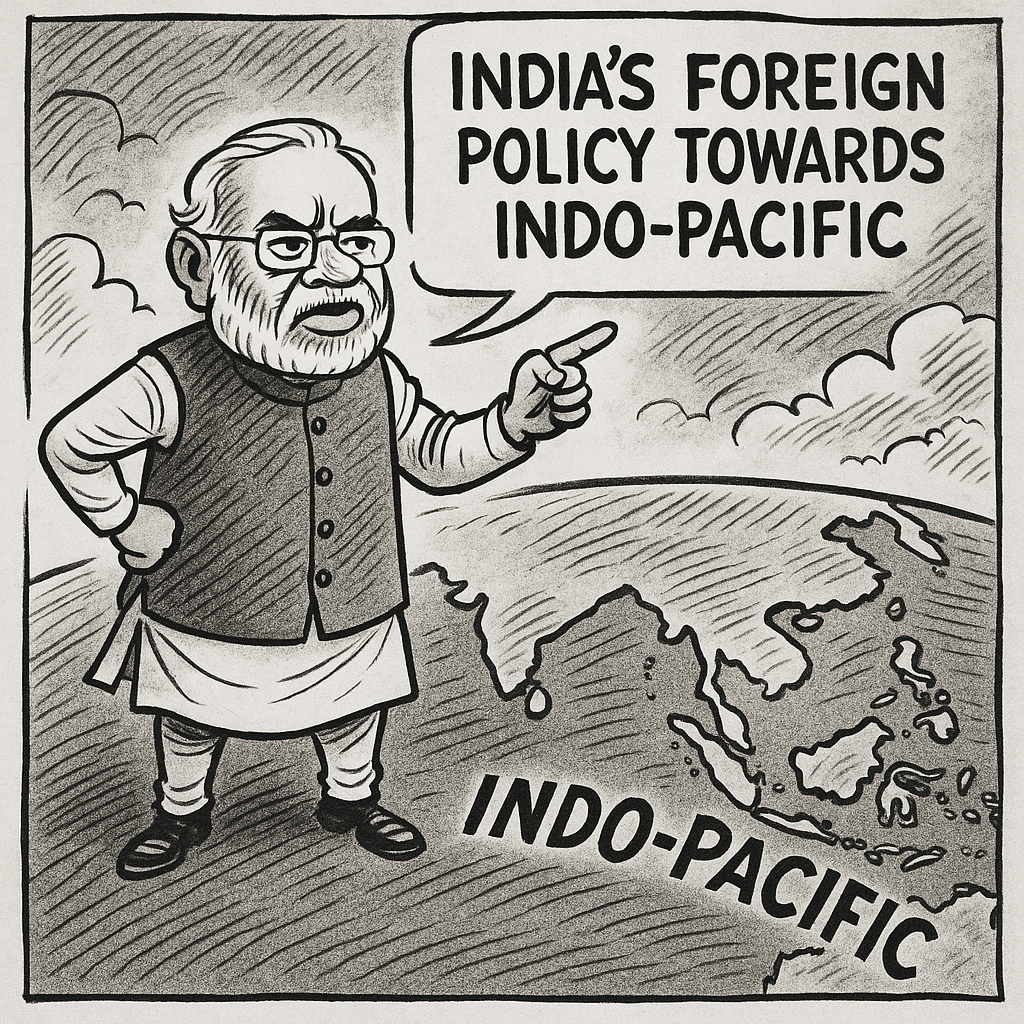India Walks the Indo-Pacific Tightrope: Strategy & Challenges
India navigates a complex Indo-Pacific strategy, balancing ties with QUAD, ASEAN, and China. Explore its diplomatic moves, security goals, and regional role.
INSIGHTS
Naman Joshi, Gaurav Upadhyay
5/21/20253 min read


The rise of China also provided an opportunity for India to know its strategic importance in the Indo-Pacific. From 1953 to 2025, the USA shifted its foreign policy from Asia-Pacific to Indo-Pacific. The geographical definition of the Indo-Pacific is not static; it may vary according to the interests of those who are defining it. PM Narendra Modi modified the Look East Policy to Act-East Policy, and now India is engaging more confidently with other East Asian countries. India has never seen the QUAD as a replacement for ASEAN. India has participated in different forums and international groups for protecting its interests in the region. India has always remained a supporter of an inclusive Indo-Pacific. India also wants a multilateral world order. Through the QUAD and BRICS, India is protecting its interests in both the territorial and maritime zones. SAGAR and SAGARMALA are the policies which influence India’s foreign policy towards the Indo-Pacific. India’s vision of the Indo-Pacific is much larger, in which countries like France also include. India's cultural connections with ASEAN and other East Asian nations have grown during the Modi administration. With the frequent meetings at the Indian Ocean Rim Association and Indian Ocean Naval Symposium, PM Modi outlined its goal to create an Indian Ocean identity.
In his chapter titled “India and Indo-Pacific Discourse,” David Scott posited that individuals adhering to Indian foreign policy would not have encountered the term “Indo-Pacific” prior to the year 2006. However, a decade later, it has emerged as a novel framework for analyzing Indian security and foreign policy. For India, the region Indo-Pacific acts as a natural habitat; it impacts India’s domestic policies as the state impacts the country. China supported the term Asia-Pacific, but the term Indo-Pacific itself drives the importance of India in the region. Indo-Pacific involves both the Pacific and Indian Oceans, but for India, in this huge territorial and water body, more precisely the eastern Indian Ocean, western Pacific Ocean, and South China Sea play an important role in framing the foreign policy.
In geopolitics, many geopolitical thinkers recognized the importance of land, but few are there who supported the dominant role played by maritime rivalries. Historian and geopolitical thinker Alfred Thayer Mahan recognized the importance of the ocean and sea. According to him, whoever controls the Indian Ocean will dominate Asia. He underscored the significance of the Indian Ocean as the pivotal waterway that connects the seven seas. During the 1990s, India opted for an extended neighborhood, which was also described as an omni-directional diplomacy. The Indo-Pacific region is very important for India in terms of foreign policy because of it, a new division was established by the South bloc known as the Indo-Pacific division, which deals with matters relating to the Indo-Pacific, India-ASEAN relations, East Asian Summit, Indian Ocean Rim Association (IORA), Asia-Europe meetings (ASEM), and Mekong-Ganga cooperation.On June 2018, Prime Minister Narendra Modi outlined India’s Vision for the Indo-Pacific region in his speech delivered at the Shangri-La Dialogue in Singapore. India advocated for an open and inclusive Indo-Pacific region based on the principles of respect for sovereignty and territorial integrity of all nations. It emphasized the peaceful resolution of disputes through dialogue and the utilization of international law and international forums. India did not exclude China from Indo- Pacific. ASEAN and SEATO were the initial organizations backed by USA to keep an eye in the region.
According to Hoffman International relations are nothing more than American social science, implying that the foreign policies of numerous countries are influenced and determined by the United States. India got its independence in 1947 and at that time India’s foreign policy was just the ideas of Nehru. Nehru supportedNon-Alignment policy and worked as a leader of third world. Cold War impacted not only the relations between East and West but it impacts very deeply global south. The Cold War was primarily characterized by the conflict between the Western bloc and the Eastern bloc. However, the global south experienced numerous conflicts during this period, resulting in significant civilian and resource losses for affected countries. Communist Party of China took over mainland China after the Korean crisis happened, and the world witnessed Chinese military and leadership capabilities. The The USA war against Vietnam was also one of the major events which justified Nehru’s Non-Alignment policy. After the 1990s, a major shift in Indian foreign policy can be seen. India’s Indo-Pacific vision is underpinned by the principle of “ASEAN CENTRALITY.” India’s approach is grounded in cooperation and collaboration, recognizing the necessity for collective responses to shared challenges within the region.
On November 04, 2019 Prime Minister Narendra Modi launched the Indo- Pacific Oceans Initiative (IPOI) at the first Asia Summit held in Bangkok Thailand. IPOI works and focused on Seven Pillars Maritime security, Maritime Ecology, Capacity Building and Resource Sharing, Maritime Resources, Reduction and management science, Technology and academic cooperation, Trade connectivity & Martine Transport.
Please note that this article is based on a research paper authored by Naman Joshi and Gaurav Upadhyay, which was published in the International Journal of All Research Education and Scientific Methods (IJARESM). https://doi.org/10.13140/RG.2.2.10454.15682
#IndoPacificDiplomacy #IndiaForeignPolicy #StrategicBalancing #QUADPartnership #RegionalSecurity #MaritimeStrategy #ChinaIndiaIndoPacific
